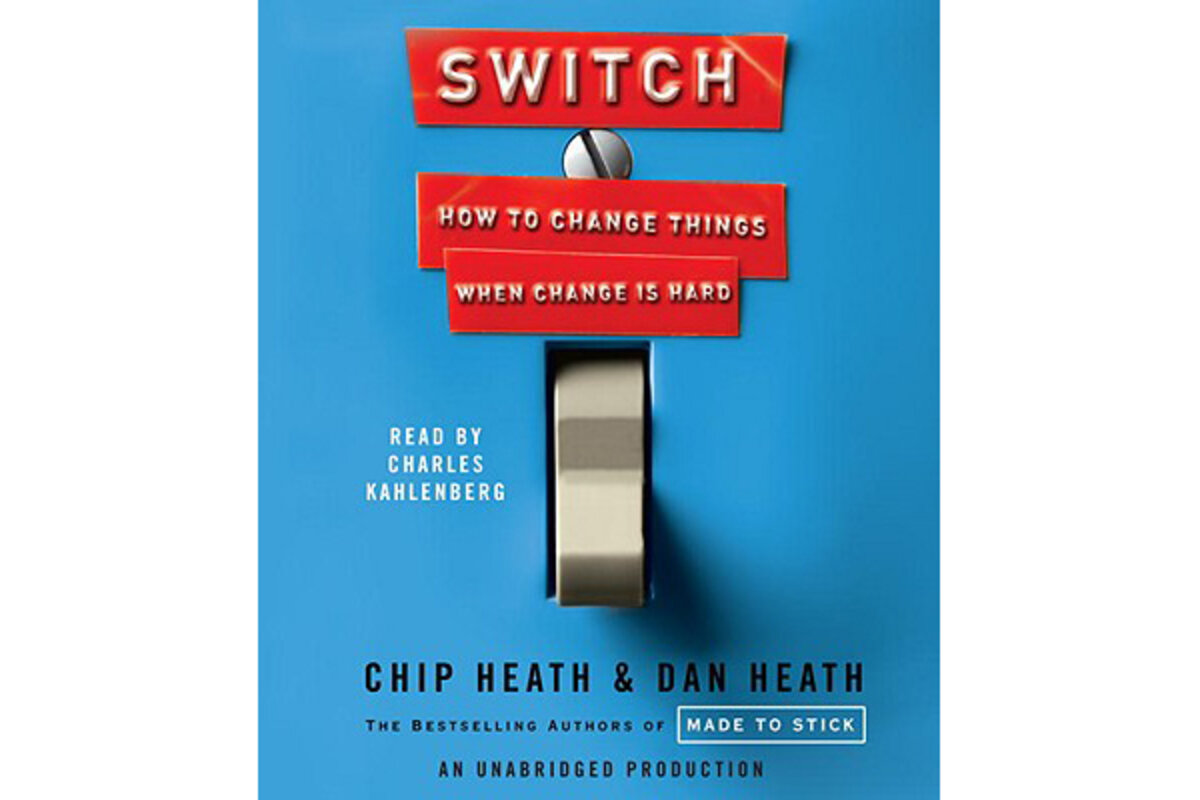Switch
Loading...
Chip and Dan Heath aim to answer this question in their new book Switch: How to Change Things When Change is Hard. The two explain that, as a culture, we tend to believe that change is often difficult if not downright impossible. But we’re wrong. The Heath brothers set out to set us straight in “Switch.” Successful change, they say, isn’t the work of magic or miracles, but a concrete formula.
This isn’t the first time the Heaths have sought to illuminate us. In their 2007 New York Times bestseller “Made to Stick,” they explained why some ideas catch on while others burn out, and how to make yours do the former. Deemed a major success by several media outlets and businesses, “Made to Stick” landed on many a “must-read” list.
Unfortunately, their newest work just doesn’t measure up.
“Switch” is broken into three sections: “Direct the Rider,” “Motivate the Elephant,” and “Shape the Path.” These zoological terms, borrowed from Jonathan Haidt’s “The Happiness Hypothesis,” mean that you must provide the analytical mind (the Rider) with a clear goal, supply the emotional heart (the Elephant) with motivation, and spell out exactly how to get there (the Path).
Aiming to bridge the gap between the self-help books directed at individuals and the “change management” books aimed at executives, the Heaths fill chapters with research, commentary, and examples to show that change is made up of the same building blocks for everyone.
They offer up some fascinating research: You’re more likely to fail at a mental task after being deprived of cookies (or setting up a bridal registry) because self-control is an exhaustible resource; appealing to someone’s identity instead of offering incentives will inspire more change; asking “What’s working and how can we do more of it?” will produce more successful results than asking “What’s broken and how do we fix it?”
It’s interesting stuff, and you might even raise a few interested eyebrows at your next dinner party when you report that only six of the 24 most common “emotion” words are positive. But the research presented in “Switch” seems to lack a personal touch. I found myself asking why the researcher cared about the study? Why did the Heaths? What did the research subjects think? Even though the Heaths interviewed many scientists for “Switch,” the reporting seemed stale.
I found myself wishing for a more emotional connection.
Or, really, even any connection at all.
Divided into sections and then chapters, “Switch” is further condensed into snippets of a few pages each. These abbreviated bits created a jarring experience instead of a smooth read and made me frustrated at the Heaths who, instead of crafting thoughtful transitions, opted for a seemingly lazy route.
The book’s examples pose another issue. There’s no doubt it’s heart-warming and motivating (the Elephant) to learn how individuals with few resources saved 122,000 lives with a simple list, revitalized a dying town by telling residents to spend more, and saved undernourished Vietnamese children by implementing the smallest dietary change.
But these examples confuse the three- pillared-structure of the book. Each section covers one third of the change equation, but the examples, mirroring successful change in action, must cover all three. The constant shift between overall message and specific details makes “Switch” seem jumbled.
Then there’s the repetition. Too often the brothers latch on to a particular example, adjective, or phrase that they then repeated over and over again. (Like calling the Rider a wheel spinner – six times in 33 pages. Or noting 11 times in three chapters how researchers increase the sale of 1-percent milk.) It’s not that these concepts and examples aren’t interesting. They are – the first time.
And what’s worse than the repetition is how it makes us feel – undervalued. When the Heaths explain three times that the Rider enjoys analyzing, making PowerPoint presentations, and seeing spreadsheets, we start to ask why the Heaths think we really need to be reminded of these simple facts over and over and over again? Instead of having us on their side, we begin to feel indignant.
Add repetition to a jarring reading experience and a shifting structure, and it starts to seem as if the text wasn’t sufficiently edited before going to the printer.
That said, “Switch” isn’t all bad.
The Heath brothers do make a good argument for their three-pronged approach, especially in their first chapter, which is dynamite. CLINICS – two-page “workshops” placed throughout the book – though a little hokey, do a good job of connecting real-world action to the Heath’s theory of change.
And there’s humor! Their parenthetical asides, though overdone, often inspire genuine laughter (as when they qualify their comparison of a difficult medical procedure to landing on an aircraft carrier: “Not that we know what either of these things feels like. We just picture both being substantially more dangerous than writing a nonfiction book.”
These men are obviously funny, and with a New York Times bestseller in their past and a popular ongoing column with Fast Company, they have all the signs of being engaging and smart, too.
This is why it’s so strange that ‘Switch” falls flat. There are too many dots that never quite connect. Sure, weeks from now, you’ll remember the Rider, the Elephant, and the Path (it’s hard to forget capitalized and oft-used names), but will you really understand how to turn those words into change?
The Heath brothers just don’t give us enough direction. And therefore, “Switch” lacks the ability to do exactly what it’s trying to teach us: implement change.
Kate Vander Wiede is a freelance writer in Boston.




